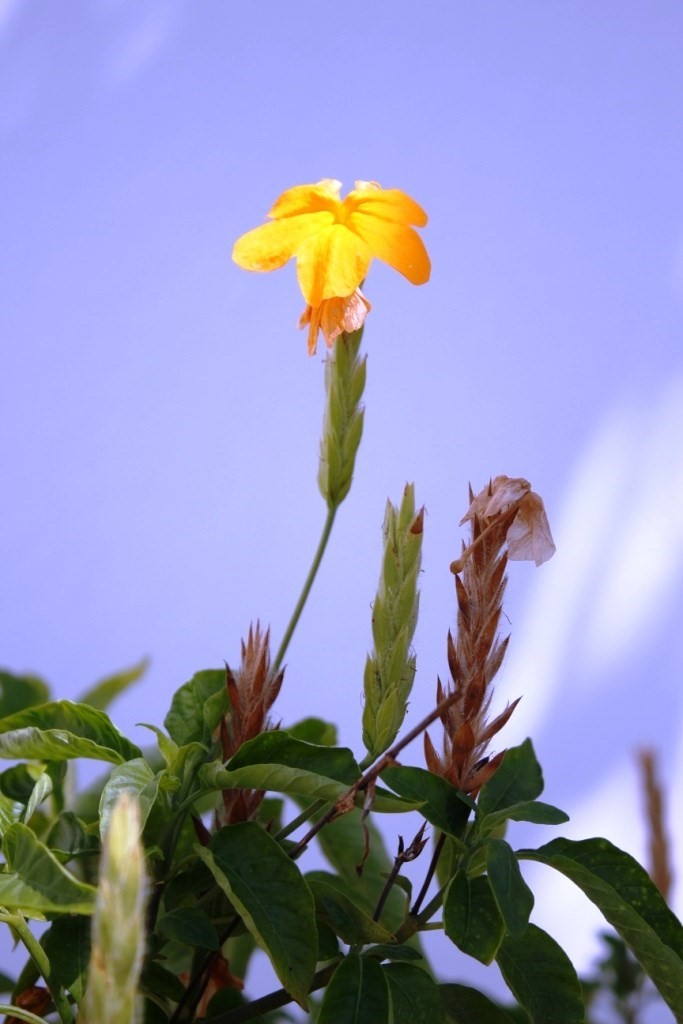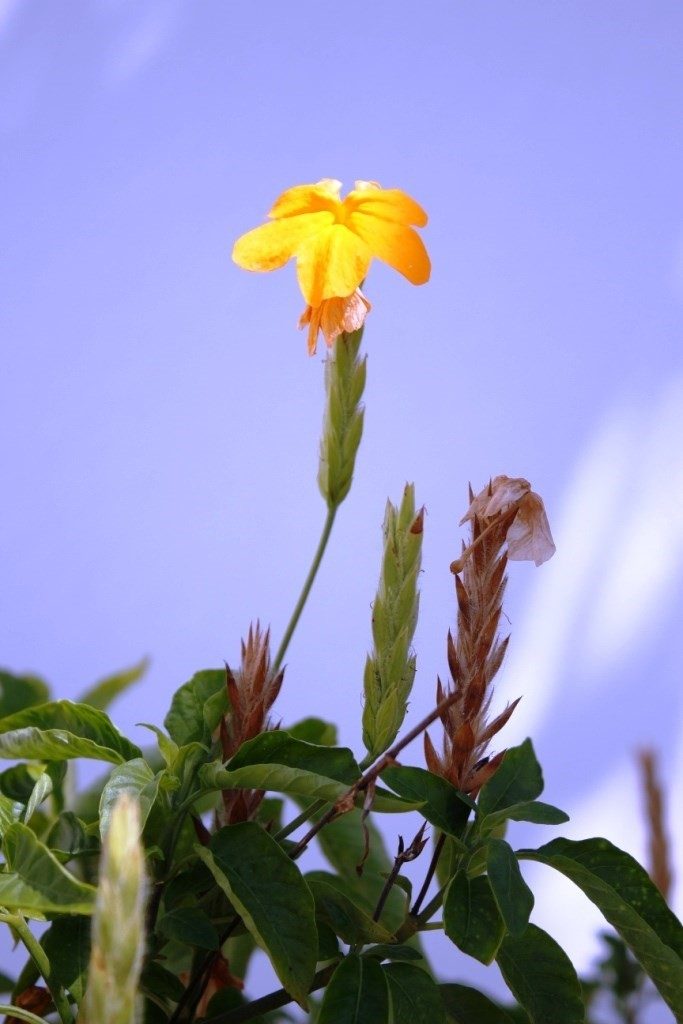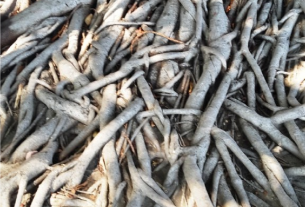By Tommy Clarkson from the November 2018 Edition
Firecracker Plant, Crossandra infundibuliformis
Family: Acanthaceae
Also known as: Firecracker Flower or Crossandra
With a genus name sounding like some cranky lady, this beauty is far from that!
In fact, thriving in a tallish pot, here in Ola Brisa Gardens, to the right of the spiral stairs – near where Patty’s car is parked – which leads to my small, new plants nursery, above my seed storage and maintenance shop, grows a most attractive Firecracker Plant that inevitably draws numerous comments by visitors.
This showy species originated in central Africa, Southern India and Sri Lanka. A smallish, evergreen shrub, it blooms during the warm months – with is pretty much year-round down here! The flowers about three to four inches (7.52 – 10.16 cm), above the foliage of the C. infundibuliformis, are often well described as being cantaloupe orange. But, actually, that’s a bit of a wide and slightly incorrect observation, with there being various shade, hues and colors.
While there are some fifty species in this genus, there are two rather commonly grown cultivars. One is ‘Lutea’ which grows erectly from one to three feet (30.48 – 91.44 cm) tall, having a shrubbier habit with yellow to light orange flowers. The other is “Mona Wallhead”, which grows a bit lower, spreads and has orange flowers. Another I’ve come across is named ‘Orange Marmalade’. (I will allow you to discern its coloration!) That said, variants of this can be found in salmon or coral pink and red colors as well.
Its velvety brown seed pod spikes should be removed before they fully mature
Unlike some folks’ children, the Firecracker Plant is not difficult to raise. Many I have seen are around two feet (60.96 cm) in height but they can reach a height of four feet (121.92 cm) if not cut back. It requires but only a regular amount of moisture – water when you notice that the soil appears to be dry – in rich, well-draining soil, in part to dappled sun. The great botanical master, Robert Lee Riffle, observed that in such locales as the latter, they are “the near perfect bedding plants. . . (with) no other plant (giving) more vibrant color to (slightly) shady situations . . . and are unexcelled (when) combined with impatiens, ferns, caladiums, and other shade loving exotics.” Moisturewise, it does prefer a higher level of humidity, if possible. Overwatering can cause them to become scraggly, with fewer flowers. Food-wise, they like an all-purpose sort but, if possible, find one that includes both major and minor elements, as well as trace minerals. As to insects, about the only one to be on the lookout for are spider mites.
Above its dark green, glossy, three to five-inch (7.62 – 12.70 cm), elliptic leaves, on four to six inch (10.16 – 12.70 cm) stalks are its salverform (meaning they’re composed of united petals forming a tube that spreads at the open end) flowers that are tubular at their base. After their brilliance has faded, I’d suggest
pruning and pinching them to encourage a more compact growth habit and for fuller branching. (By the way, cuttings can be used for propagation.) Speaking of cutting: Those velvety brown seed pod spikes take a bit of maintenance in that they should be removed before they fully mature, in order to keep the plant blooming.
-
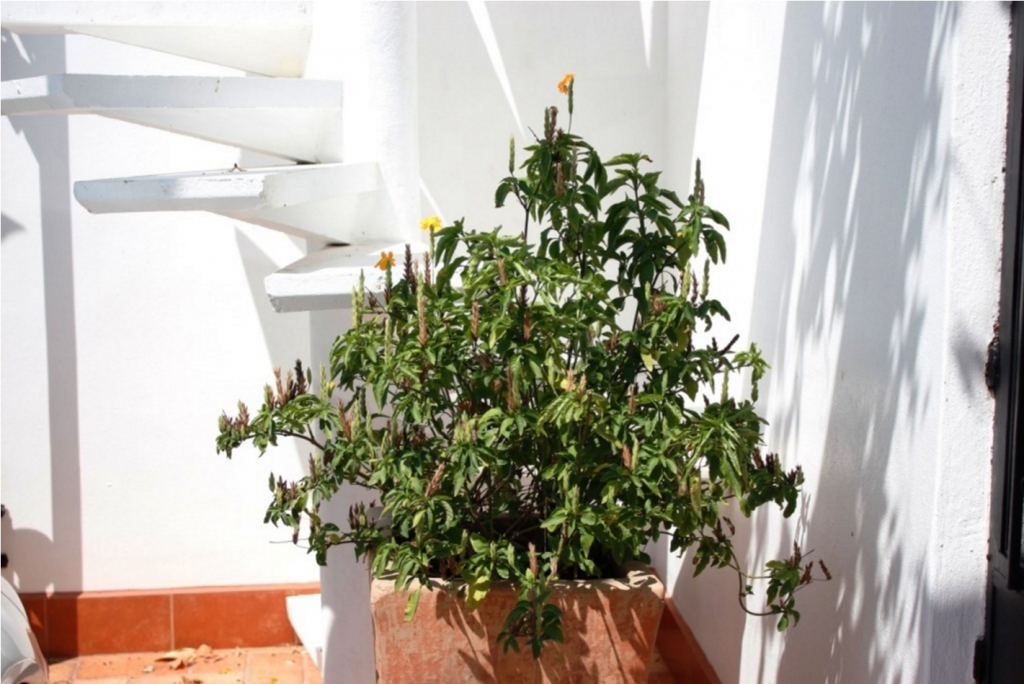
Thriving in a tallish pot, here in Ola Brisa Gardens, grows a healthy Firecracker Plant – which by the absence of flowers, appears here to have been a bit overwatered!
Thriving in a tallish pot, here in Ola Brisa Gardens, grows a healthy
Firecracker Plant which by the absence of flowers, appears here to have been a bit overwatered!
In her book, Gardener’s Guide to Tropical Plants, Nellie Neal, speaks of these flowers in this manner. “Abundant green leaves, shiny with deeply marked veins, cover the firecracker flower . . . The leaves are arranged in a lateral form, reminiscent of dogwood but more dense layers. . . . They jut out like strong chins determined to fulfill a mission in this case, to show off magnificent flower clusters.
The blooms are shaped like funnels with five lobes that spread out flat and almost upturned like a crooked smile. . . . Dynamic, charming, and unusual enough to be real conversation pieces, (the) Firecracker flower is small but powerful in raised beds, window boxes and baskets.”
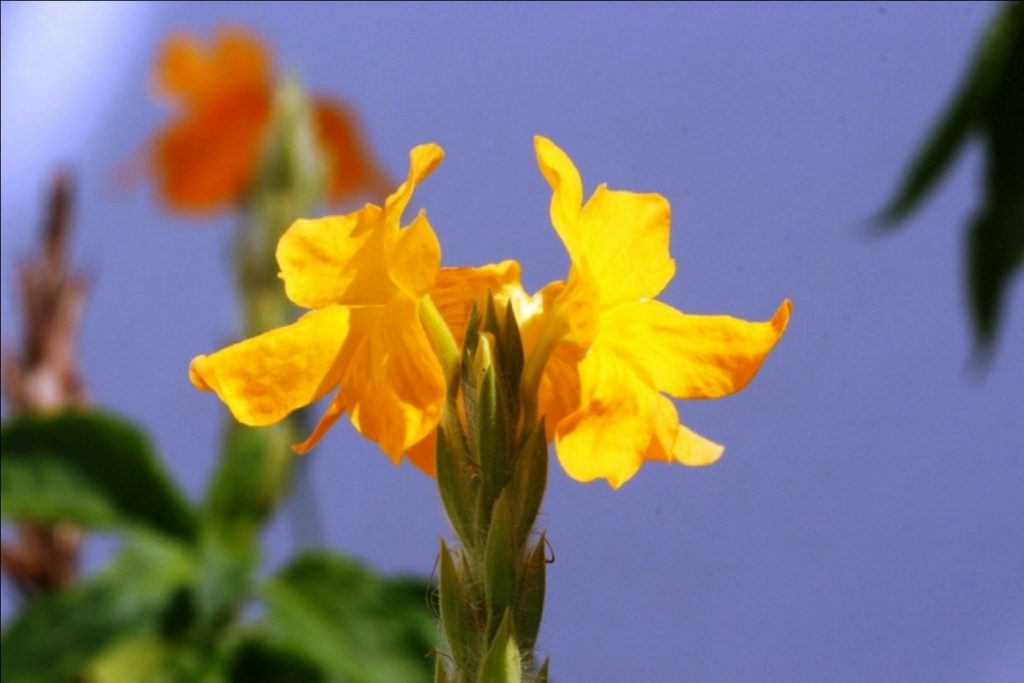
The Firecracker Plant’s flowers are salverform and tubular at their base.
(Why, I must ask myself, try to state something when someone else has already said it well?) Ellen Zachos, in her book, Tempting Tropicals, described the Firecracker Plant succinctly when she wrote, “Its growing habit, is mounded and compact, and the contrast between the glossy green foliage and the warm orange flowers is stunning. There’s something about the reflective, shiny leaves and soft plentiful flowers that is both perplexing and satisfying. How can something be soft and hard at the same time? Grow Crossandra infundibuliformis and find out.”
The full edition or view it online
—
Tommy Clarkson is a bit of a renaissance man. He’s lived and worked in locales as disparate as the 1.2 square mile island of Kwajalein to war-torn Iraq, from aboard he and Patty’s boat berthed out of Sea Bright, NJ to Thailand, Germany, Hawaii and Viet Nam; He’s taught classes and courses on creative writing and mass communications from the elementary grades to graduate level; He’s spoken to a wide array of meetings, conferences and assemblages on topics as varied as Buddhism, strategic marketing and tropical plants; In the latter category he and Patty’s recently book, “The Civilized Jungle” – written for the lay gardener – has been heralded as “the best tropical plant book in the last ten years”; And, according to Trip Advisor, their spectacular tropical creation – Ola Brisa Gardens – is the “Number One Tour destination in Manzanillo”.
